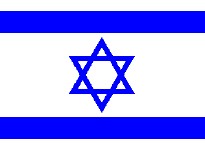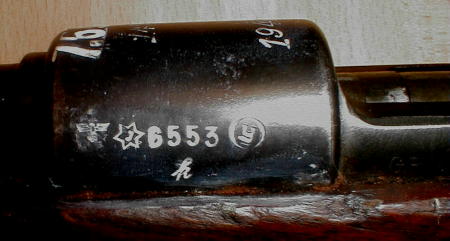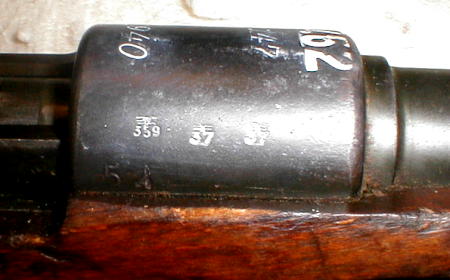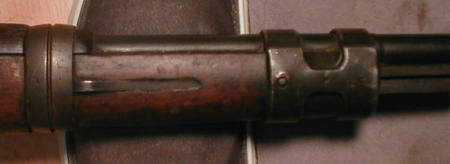 |
Israeli 7.62mm
K98k
Carbine |
 |
|
|
|
|
CRUFFLER.COM
presents
FIREARM
REVIEW,
January
2001:
 |
Israeli 7.62mm
K98k
Carbine |
 |
 |
|
Caliber: 7.62mm NATO Capacity: 5 round internal box magazine Sights, front: Blade, adjustable for windage Sights, rear: Tangent U-notch adjustable for range Length: 43.7" Barrel length: 23.62" Weight (unloaded): 8.6 lbs Suggested Retail Price: $240.00 |
 |
The K98k's service life continued after the war, arming a number of liberated European nations. In addition to the K98k, France also used Panther tanks, Walther pistols, and Messerschmitt aircraft. Norway had its K98k's rebarreled to use American .30-06 ammunition. Czechoslovakia and Belgium went a step further and kept the K98k in production for a number of years after the war. Indeed, a strong case can be made for naming the K98k the most widely used service rifle of the immediate postwar era. It was also one of the least expensive, with literally millions of them littering the battlefields of Europe, stored in the arsenals of liberated nations, and in the warehouses of the victorious allied powers. As a result, tens of thousands of these rifles were purchased by arms dealers, small countries, and many organizations of dubious legality.
One of these
organizations was the Haganah. The Haganah, founded in 1920, evolved
into
the primary self-defense military organization of the Jewish community
in what was then Palestine (and later into the nascent Israel Defense Force
- the IDF). In addition to the duties of protecting the scattered
Jewish settlements from Arab attacks, organizing and arranging for the
illegal immigration of Jewish Displaced Persons (DP's) from postwar Europe
to Palestine, and operation against the British occupation forces, the
Haganah was responsible for both acquiring arms from abroad and arranging
for domestic arms production. (The full story of the Haganah's underground
arms acquisition program is told in Leonard Slater's excellent book, The
Pledge.) Among the arms brought in during the period between
the end of World War II (1945) and the Israeli War of Independence (1948)
were thousands of surplus German K98k's. The K98k acquitted itself
well in Israel hands during that conflict. Afterwards, it was adopted
in caliber 7.92x57mm as the standard rifle of the IDF. Additional
contracts for new K98k's were let with both the Czechoslovakian state arms
factories and FN, so that by the early 1950's K98k's in Israeli service
included a mixture of German wartime guns, Czech and Belgian postwar production.
| Arms technology advanced rapidly after World War II, and armies sought to put self-loading and selective fire rifles chambered for new cartridges into the hands of their troops. Israel was no exception and by 1958, she had adopted the FAL in 7.62mm NATO as her new standard rifle. A problem arose as there were literally tens of thousands of 7.92mm K98k's in inventory, and these guns formed the bulk of the armament for the reservists that were the majority of Israel's wartime manpower. Israel was faced with the alternatives of complicating an already stressed wartime logistics system with the issuance of two types of battle rifle ammunition, rechambering the K98k's for 7.62mm NATO, or pushing forward, at financial peril, the schedule for rearming the reserves. In the event, the Israelis settled on a program of rechambering the K98k's on hand for the 7.62mm NATO cartridge. Rechambered K98k's were rebarreled with new, Israeli made 7.62mm barrels, fitted with a magazine block (the 7.62mm NATO is 6mm shorter than the 7.92x57mm) and a new |
I personally own 3 Israeli K98's, and I have fondled several others. My own Israeli Mauser collection consists of: The first is a CZ manufacture K98 with a lion's crest on the receiver, faded blue finish with some green parts, very well-shot bore, mismatching completely, wood is grease soaked and also well worn and has the standard 7.62 burned into the wood. This weapon shows evidence of being used extensively. The second is a DOU 45 German K98 that really looks new. The bore is either new, or shot very little. The green phosphate finish is close to 99% on the entire weapon. The receiver and bolt, the only numbered parts, match (This is the only matching Israeli mauser that I have ever seen). The stock looks new with minor handling marks, and the wood has 7.62 burned into it. This rifle shoots very well. The third is a 237 code, early German K98. Like the DOU 45, this Mauser is in very nice shape. The wood is pretty with some nice figure, and it has the 7.62 burned into it as well. The overall finish is a green phosphate, and the finish is almost perfect. The bolt is unmatching. The bore is like new. At some time in this rifle's life, someone had tapped three holes in the left side of the receiver. These holes are filled with screws now and are not horribly noticeable. In the accompanying article,
an attempt was made to decipher the type of wood the Israelis used in their
stocks, and if the stock configuration was from an earlier German model.
I have discovered through examination of my
Nate Sanborn
|
The 7.62mm K98k's proved to be a great success, and were used in combat as late as the 1973 Yom Kippur war. Nevertheless, by the 1970's it was evident that the K98k's were obsolete as battle rifles. Some were retained for training use, but by the late 1980's most had been sold to developing nations or companies specializing in the surplus military weapons trade.
PRODUCT
REVIEW
Israeli 7.62mm
K98k's hold a special historical interest. The juxtaposition of rifles
designed for an evil power whose avowed goal was the destruction of every
Jew in the world later serving to help create and defend a Jewish
state is fascinating in and of itself. The fact that they are chambered
for inexpensive and readily available 7.62mm NATO ammunition is an additional
benefit. The current shipment was imported by Century
International Arms of St. Albans, Vermont, and is offered for sale
by both Century and Southern Ohio
Gun (SOG) of Lebanon, Ohio. Curious about these guns, we phoned
SOG and placed an order for what was described as a ".308 German K98,"
paying an extra $10.00 for a "hand picked" specimen. The rifle arrived
about a week later.
External Inspection
Markings
The K98k we
received was indeed a German World War Two service arm. The top of
the receiver ring was marked "7.62" in large letters stamped into the forward
edge, indicating the caliber conversion. Below that were the italicized
numbers "147" and below that an italicized "1940." From this we were
able to determine that this particular rifle was made in 1940 at the J.P.
Sauer & Son rifle factory in Suhl, Germany. The left side of
the receiver has a peened out, but still very

Receiver, Left Side. Note unsuccessfully peened German firing proof to the left of Israeli proof, large 7.62 stamped on receiver ring, "147" makers code and 1940 production date. |

Receiver, Right Side. Note original Waffenamt inspector's stamps indicating no attempt at obliteration. |
(Editor's Note: The only Nazi marking showing any evidence of an attempt at obliteration is the firing proof. Given the plethora of additional German World War II markings, it is our surmise that this has more to do with indicating that the original proof was no longer applicable than an attempt to ideologically "purify" the rifle in the manner of the Soviet obliteration of Czarist property markings on Mosin-Nagant rifles.)
Parts Mixture
Characteristic
of a military firearm that has been through at least one arsenal rebuild,
the K98k showed an almost haphazard amalgamation of parts. The barrel
bands are of the early milled type, as is the magazine floorplate.
The triggerguard is stamped. The rear sight base is from a very early
K98k, but the rear sight leaf is of the post-1942 type with no markings
on the obverse side. Perhaps the most interesting part is the stock.
It is of the cup buttplate style, and the cup buttplate is of the late
type with the opposed bolt disassembly holes in the lower portion of the
buttplate. While this is typical of a late war K98k stock, there
are several features that indicate that this is not a late war K98k stock.
To begin with, the stock is made of a single piece of walnut - most late
war stocks were of the laminated type. The most interesting part
of the stock was what it did not have.

Barrel Bands and Retaining Spring and Pin. This is NOT a typical K98k arrangement. |
The key feature which identifies a rifle as a K98k and not one of the many Mauser short rifle components that came before is a simple spring. Specifically, it is the leaf spring which retains both the upper and lower barrel bands. On true K98k stocks, this spring rides in a channel on the right side of the stock between the |
On our rifle, the lower band was retained by an L-shaped spring like the ones used on Mauser long rifles. The upper band is retained by means of a transverse pin which goes through the stock and holes in both sides of the band. Our first thought upon seeing this was that the stock was a Gewehr 98 stock which had been reworked for a K98k, but we could find no evidence of there ever having been sling swivels on the heel of the stock. Alternatively, it could have been a Kar. 98a or Kar. 98b stock, but it lacked evidence of ever having had disassembly washers. At this point the stock's provenance remains unclear, but we did note that overall wood to metal mating was exceptionally good.
Condition
Overall, the
rifle rates a solid "very good." The metal parts, while they show
ample signs of use bear no evidence of abuse, and retain between seventy-five
and eighty percent of the blued finish. It is doubtful that any of
this is the original finish applied by the Sauer factory; more likely it
is the remnant of the most recent Israeli arsenal rebuild. The stock
is in similar very good condition. While there are some scratches
and compression marks, there are no gouges or deep dings. The stock
should clean up very nicely with a minimum of effort. The bore
was coated in some form of preservative when we received the rifle.
In fact, the condition appeared to be "muddy" at best. A few patches
and some brushing later, we were very happily surprised to see a bore that
was bright, shiny, and looked new.
Headspace
A headspace
check was positive, with the bolt closing easily on a Clymer
.308 Winchester GO headspace gauge (1.630"), and failing to close on a
NO-GO gauge (1.634"). A word on cartridge interchangeability
is in order here. The .308 Winchester and the 7.62mm NATO cartridges
are not the same, nor are they interchangeable despite similarities in
external dimensions. The 7.62mm NATO
cartridge
has a maximum chamber pressure of approximately 50,000 pounds per
square inch,
the .308 Winchester has a maximum chamber pressure of approximately 66,000
pounds per square inch. This is not to say that all .308 Winchester
loads will develop such pressures, merely that they may, and would be within
manufacturing tolerances if they did so. Consequently, CRUFFLER.COM
strongly recommends against ever firing .308 Winchester ammunition in a
firearm chambered for the 7.62mm NATO. Doing so risks damage to the
firearm and injury to the shooter. The Israeli K98k is chambered
for the 7.62mm NATO cartridge and not the .308 Winchester. Given
the abundance of inexpensive military surplus 7.62mm NATO ammunition available
today, shooters have no reason to resort to shooting .308 Winchester in
military rifles like the K98k.
Shooting
the Israeli K98k
We were enthusiastic
about shooting the 7.62mm K98k. We gathered up the necessary ammunition
and accouterments and headed off to the NRA range in Fairfax, Virginia.
Ammunition
We brought
along three types of 7.62mm ammunition with which to test the Israeli K98k:
Portuguese
FNM 7.62mm NATO 147 grain FMJ
Argentine
FM 7.62x51mm 147 grain FMJ
US M80 7.62mm
NATO 147 grain FMJ
Accuracy
Our initial
accuracy results indicated that, as with most K98k's in good mechanical
condition, the gun was capable of far better accuracy than we were.
In fact, one of the most accurate military rifles we've had the pleasure
to shoot is a Norwegian K98k that had been rebarreled by the Norwegian
military to .30-06. The Israeli 7.62mm variant was not far behind
in accuracy. The rifle was zeroed at fifty feet, shooting cloverleaf
groups approximately an inch to the right and two inches low of the point
of aim when using the 100m sight setting. We then reeled the rifle
out to 50 yards, the maximum distance at the NRA range. After some
initial difficulties getting used to the Mauser sights, we were firing
some very nice three shot groups. Our best group of the day was shot
with the Portuguese ammunition, and measured a little more than .75", center
to center. Even our worst group, fired with the Argentine ammunition,
was only 1.75". Most groups averaged about 1.25" and we are sure
that in more capable hands, with superior ammunition, this rifle has the
capability to deliver even better accuracy.
As noted, we held the rifle to between one and a half and three and a half minutes of angle, which compares very favorably with the modern crop of evil black rifles, which are designed to shoot approximately three minutes of angle. Indeed, part of the fun of owning an old war horse like the Israeli 7.62mm K98k is watching the looks of stunned disbelief on the faces of shooters raised on expensive military style autoloaders as an old $200.00 bolt action rifle consistently out shoots the pricey self loaders on the line!
Recoil and
Ergonomics
Recoil with
a 7.92x57mm K98k firing the 198 grain sS bullet is healthy but not unpleasant.
Moving down to a 147 grain bullet seems to have salutary effects on recoil
sensation, as it is appreciably lighter. While still appreciable,
this rifle was no less pleasant to fire than an FAL or an M1A, and significantly
more pleasant than the G3 clones we've shot. There was no pain associated
with shooting the 7.62mm K98k, and firing one or two hundred rounds in
an afternoon's plinking should not daunt anyone.
The K98k is an exceptionally handy and well balanced rifle. While it may seem a bit heavy for American shooters accustomed to featherweight hunting rifles, the weight aids in soaking up recoil and in helping to steady the rifle for offhand shooting. Perhaps the biggest complaint one can make is with the sights. These are typical European military sights - tiny v notch on the barrel mounted tangent sight, and a thick inverted v foresight. While suited for precision shooting, they are at best an acquired taste. They can be difficult to acquire and maintain once on target. Nevertheless, once the shooter learns how to use them, they can prove very effective.
Reliability
As the K98k
is a manually operated arm, we expected, and received no failures or difficulties
to feed, extract, or eject. The bolt never became sticky or difficult
to manipulate.
Conclusion
In many ways
the Israeli K98k's are Cruffler Grail. They have a fascinating and
compelling history in a way that few others firearms do; all at once they
represent the despair, destruction, hope and rebirth of a people.
As if this wasn't enough, they are excellent shooters chambered for a popular,
readily available and inexpensive cartridge. Additionally, they are
very reasonably priced; holders of Type 01 or Type 03 FFL's can obtain
these fine rifles for significantly less than $200.00. All this adds
up to only one possible recommendation: Don't pass these rifles up!
And now, our
Buy-O-Meter rating for the Israeli 7.62mm K98k:
 |